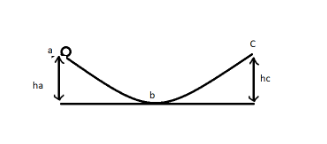
The ball rolls down without slipping (which is at rest at $a$) along $ab$ having friction. It rolls to a maximum height${h_c} $where $bc$ has no friction. ${K_a} $, ${K_b} $and ${K_c} $ are the kinetic energies at $a,b$ and $c$. Which of the following is correct?
A) ${K_a} = {K_c},{h_a} = {h_c}$
B) ${K_b} > {K_c},{h_a} = {h_c}$
C) ${K_b} = {K_c},{h_a} < {h_c}$
D) ${K_b} > {K_c},{h_a} > {h_c}$


Answer
564.3k+ views
Hint:The energy that an object retains is potential energy regardless of its location with respect to other objects, the tension within itself, its electricity or other causes.
Popular forms of potential energy include the gravitational energy of an object, the force of an expanded spring, the electrical potential energy of an electric charge in an electric field, and its distance from the centre of mass of another subject. The energy unit of the International Unit System (SI) is the Joules. Potential energy is related to forces which act on a body in a manner which only depends on the body's original and final locations in space. These forces, known as conservative forces, will at any point in the space be described by vectors expressed as gradients of some scalar function called potential.
Step by Step Solution:
Since the ball rolls without slipping, no loss of energy into heat.
Initial ball has only Potential Energy.
At $b$ , it has Kinetic Energy.
And rotational $E$
At $c$ it has Potential Energy and R.E.
(Frictionless $bc$ so ball will continue rotating) so ${K_b} > {K_c}, {h_a} > {h_c} $
Final answer is D
Note:There are different types of potential energy, each with a specific form of force. For example the work of an elastic force is called the elastic energy potential; the work of a gravitational force is called the energy of a gravitational potential; the work of the Coulomb Forces is called electric energy of potential; the work of a barium power or weak nuclear power is called nuclear potential energy; The work of Coulomb 's power during the rearrangement of electrons and nuclei structures in atoms and molecules is chemical potential energy, including energy contained in fossil fuels. Thermal energy typically has two elements: kinetic energy and potential energy for the arrangement of the spontaneous movements of the particles.
Popular forms of potential energy include the gravitational energy of an object, the force of an expanded spring, the electrical potential energy of an electric charge in an electric field, and its distance from the centre of mass of another subject. The energy unit of the International Unit System (SI) is the Joules. Potential energy is related to forces which act on a body in a manner which only depends on the body's original and final locations in space. These forces, known as conservative forces, will at any point in the space be described by vectors expressed as gradients of some scalar function called potential.
Step by Step Solution:
Since the ball rolls without slipping, no loss of energy into heat.
Initial ball has only Potential Energy.
At $b$ , it has Kinetic Energy.
And rotational $E$
At $c$ it has Potential Energy and R.E.
(Frictionless $bc$ so ball will continue rotating) so ${K_b} > {K_c}, {h_a} > {h_c} $
Final answer is D
Note:There are different types of potential energy, each with a specific form of force. For example the work of an elastic force is called the elastic energy potential; the work of a gravitational force is called the energy of a gravitational potential; the work of the Coulomb Forces is called electric energy of potential; the work of a barium power or weak nuclear power is called nuclear potential energy; The work of Coulomb 's power during the rearrangement of electrons and nuclei structures in atoms and molecules is chemical potential energy, including energy contained in fossil fuels. Thermal energy typically has two elements: kinetic energy and potential energy for the arrangement of the spontaneous movements of the particles.
Recently Updated Pages
Why are manures considered better than fertilizers class 11 biology CBSE

Find the coordinates of the midpoint of the line segment class 11 maths CBSE

Distinguish between static friction limiting friction class 11 physics CBSE

The Chairman of the constituent Assembly was A Jawaharlal class 11 social science CBSE

The first National Commission on Labour NCL submitted class 11 social science CBSE

Number of all subshell of n + l 7 is A 4 B 5 C 6 D class 11 chemistry CBSE

Trending doubts
10 examples of friction in our daily life

One Metric ton is equal to kg A 10000 B 1000 C 100 class 11 physics CBSE

Difference Between Prokaryotic Cells and Eukaryotic Cells

1 Quintal is equal to a 110 kg b 10 kg c 100kg d 1000 class 11 physics CBSE

State the laws of reflection of light

Explain zero factorial class 11 maths CBSE




